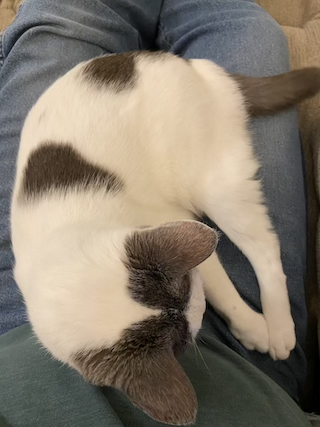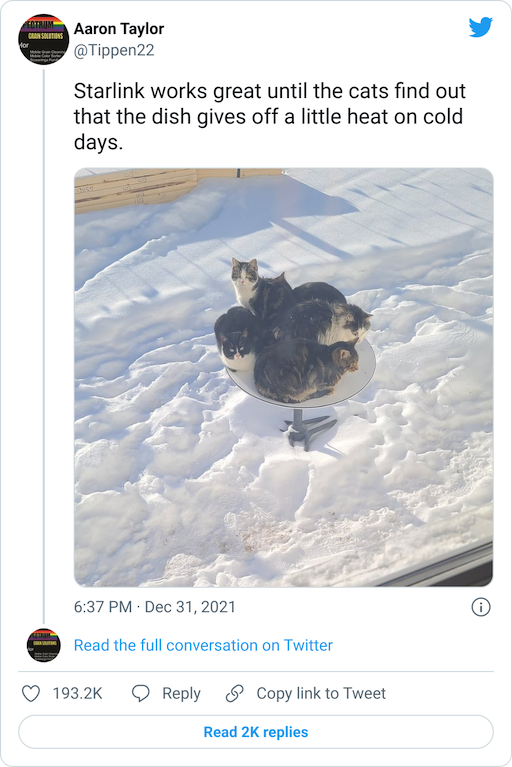Issue 81: Controlled Digital Interlibrary Lending, Gamers Revolt Against NFTs, and Cats

Hey...I'm not above using cat pictures to satisfy readers. In fact, I'm going to do it one more time before this newsletter is finished. (Oh, and if you are not seeing the pictures in your email, go ahead and click on the "load remote images button"—these are shared from my own site and there are no trackers in use.)
Thanks for the feedback on Thursday Threads—it has been very helpful. With this issue, I think you'll notice the email has a better visual look. The website of back issues has some improvements as well, and I'm starting to get into the swing of converting old posts to the new format.
The threads this week:
- Controlled Digital Lending Gets a Funding Boost
- Gamers Pushing Back Against Non-Fungible Tokens
- Cat Dish
Feel free to send this newsletter to others you think might be interested in the topics. If you are not already subscribed to DLTJ's Thursday Threads, visit the sign-up page. If you would like a more raw and immediate version of these types of stories, follow me on Mastodon where I post the bookmarks I save. Comments and tips, as always, are welcome.
Controlled Digital Lending Gets a Funding Boost
The Davis Educational Foundation has awarded the Boston Library Consortium a two-year $215,000 grant to accelerate the implementation of controlled digital lending as a mechanism for interlibrary loan. The grant supports plans described in BLC’s 'Consortial CDL: Implementing Controlled Digital Lending as a Mechanism for Interlibrary Loan' report published in September 2021.
The National Information Standards Organization (NISO) today announced that it has received a grant of $125,000 from The Andrew W. Mellon Foundation to support the development of a consensus framework for implementing controlled digital lending (CDL) of book content by libraries, which has been approved by NISO members as a new initiative.
From my perspective, controlled digital lending for interlibrary loan (or "CDILL") is gaining steam. (I'm trying to make "CDILL" stick as a way of differentiating this type of controlled digital lending from the kind where a library uses CDL techniques to offer its own materials to its own patrons.) These two funding announcements show support for the development of systems and practices for libraries to advance the cooperation beyond the point of shipping physical books back and forth. (Although shipping physical books back and forth is still a noble effort by libraries, as last week's ode to interlibrary loan demonstrated.)
The key to making this work is having a workflow where the physical item is taken out of circulation in one place so that it can be digitally lent to another place. By replicating the same "friction" of physical interlibrary loan—ensuring that only one patron has access to the intellectual content of the book at a time—libraries retain the rights under copyright to lend books. This legal theory hasn't been tested in court, and there are some corners of the publishing industry that are against it. My opinion is not a legal one, but this all makes sense to me.
The Mellon funding to NISO supports a working group that is developing a recommended practice for an "Interoperable System of Controlled Digital Lending". I'm participating in the group along with about 30 other information professionals, and we held our kick-off meeting earlier this month. This is an area where standards, and in particular extensions to existing standards, will greatly help disparate systems effectively work together to make this happen. Notably, the working group is starting from the assumption that CDILL is legally sound; from that assumption, what would be required to make the workflow as smooth as possible for patrons and library staff? The working group has 24 months of activities to answer that question, and I'll report more on DLTJ as that work comes to its conclusions.
Related to the first quote above from the Boston Library Consortium, there is new development happening with the open source Project ReShare to develop a CDL module under its umbrella. A great software development team from Knowledge Integration in the U.K. is joining forces with my employer, Index Data, and others to make this happen. I'm not directly involved in this effort, but I get the professional pleasure of watching it come to life.
Gamers Pushing Back Against Non-Fungible Tokens
For more than a year, crypto mania has been at a fever pitch. Cryptocurrencies such as Bitcoin and Ethereum have soared in value. Crypto-based assets like NFTs have taken off. Jack Dorsey, a Twitter founder, recently renamed one of his companies Block in honor of the blockchain, the distributed ledger system that powers digital currencies. Melania Trump has auctioned off her own NFTs. Proponents hope that blockchain will revolutionize industries, from finance to social media to art.
But to some, the crypto craze has gone too far, too fast. Skeptics argue that cryptocurrencies and related assets like NFTs are digital Ponzi schemes, with prices artificially inflated beyond their true value. Some question whether cryptocurrencies and the blockchain, which are slippery concepts, have any long-term utility.
Nowhere has there been more unhappiness than in the games community, where clashes over crypto have increasingly erupted between users and major game studios like Ubisoft, Square Enix and Zynga. In many of the encounters, the gamers have prevailed — at least for now.
For Thursday Threads readers that are not tuned into cryptocurrencies and non-fungible tokens (NFTs) yet, I know I haven't laid the foundations of what these things are and how they are interrelated. This thread started last week with the problems of cryptocurrency energy consumption. (Update! The cryptocurrency miners in Kosovo are desparate to unload their equipment.) And the thread will continue with problems the high concentration of cryptocurrencies in the hands of a few individuals, the mysterious movement of billions of dollars on the blockchain, how centralized this self-described decentralized platform is, the tenuous link between what you think you're buying and what you are actually buying, how "sockpuppets" are driving up the value of artificially scarce resources, and many more. (Stay tuned!)
This article from The New York Times, though, was too good to pass up right now. It has a useful simplified definition of NFTs: The digital assets, which are verified by blockchain technology, give proof of authenticity and ownership. That provides gamers with unique digital items, game makers said, which can enrich those that sell the NFTs in online marketplaces. It also starts to get to some of the controversies: “I just hate that they keep finding ways to nickel-and-dime us in whatever way they can,” said Matt Kee... “I don’t see anywhere mentioning how that benefits the gamer, how that improves gameplay. It’s always about, ‘How can I make money off this?’”
There are some serious problems with this technology, and the problems threaten us in real-world ways.
Cat Dish

Here is the promised cat picture at the bottom of the newsletter. I found this via a Smithsonian Magazine article. The dish featured in the photograph is from SpaceX's Starlink internet broadband service. The article goes on to explain that the Starlink dishes have heaters built into the faces to help melt snow. It all becomes clear now why the cats were attracted to the dish.
What was the best part of this issue? The overview of Controlled Digital Interlibrary Lending? The introduction of a new cryptocurrency horror? The pictures of cats?
Let me know by replying to this newsletter, and I'll make more of it happen.